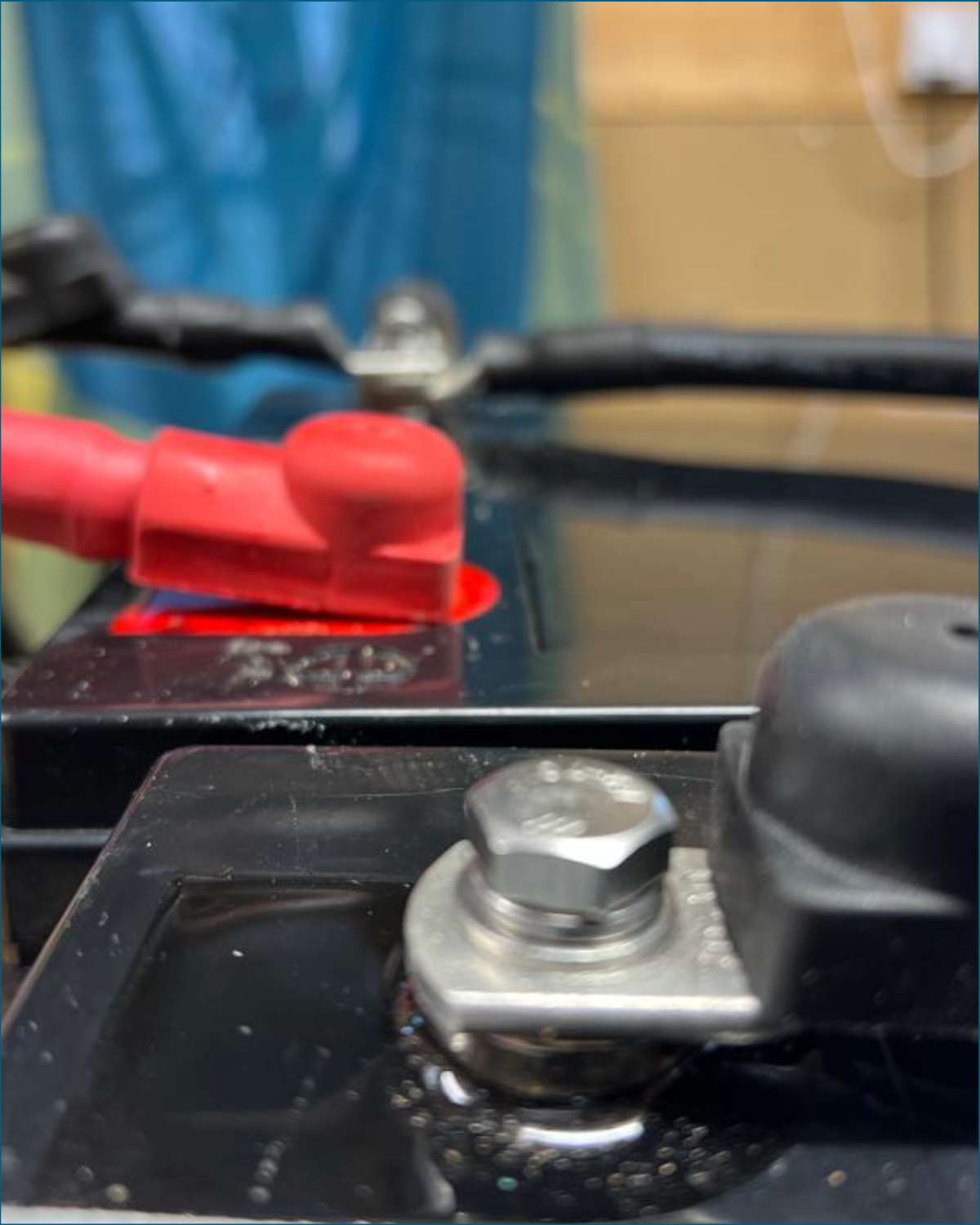Are you asking how much solar power you need for your RV? Then, our ultimate guide to sizing your RV’s solar system has got you covered!
Are you considering taking your RV off the grid and relying on solar power for your energy needs?
It’s a great way to enjoy the freedom of the open road without worrying about finding an electrical hookup or running out of generator fuel.
But before you hit the road with your solar panels in tow, it’s important to figure out how much power you’ll actually need to keep everything running smoothly.
From charging your devices to powering your refrigerator, there are a lot of factors to consider when sizing your solar panel system for an RV setup.
In this article, we’ll break down some key considerations and provide tips for determining the right amount of solar power for your unique needs – so you can travel confidently and sustainably!
Learn how to:
- calculate your daily energy consumption,
- determine battery capacity,
- choose the right solar panels,
- and more.
Say goodbye to noisy generators and campground hookups and hello to eco-friendly off-the-grid adventures.
At A Glance: How Much Solar Power Do I Need For My RV?
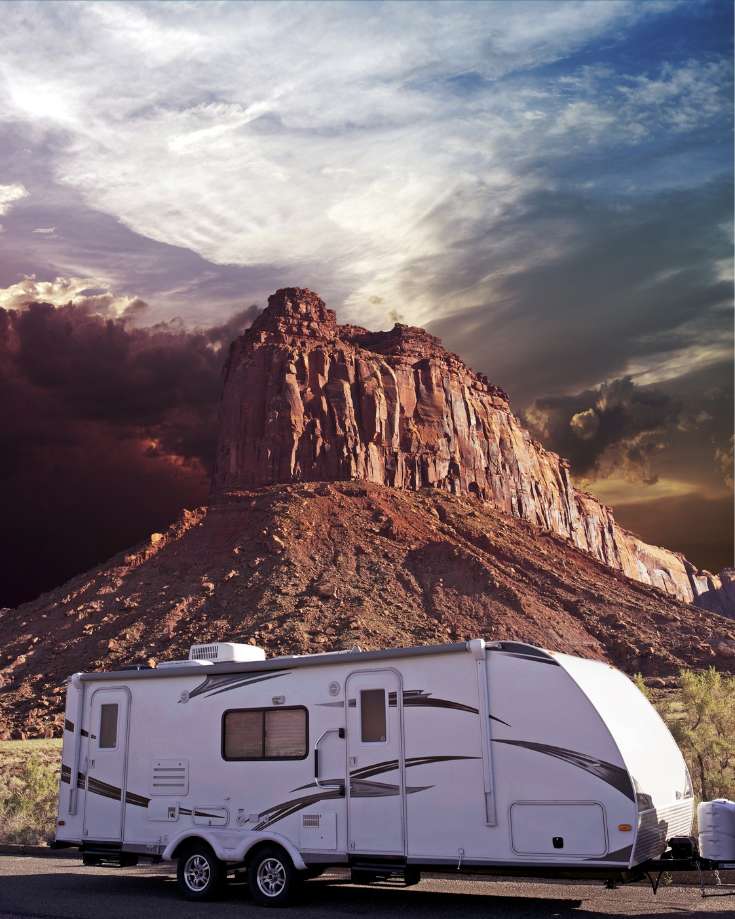
Determining how much solar power you need for your RV may seem daunting, but it’s essential for successful boondocking and off-the-grid adventures.
By investing the time to get this step right up front, you’ll save yourself from the headache of running out of power when you need it most.
Properly sizing your RV solar system can save you money in the long run by avoiding over or under-sizing your system.
Plus, with solar energy becoming more and more accessible, there’s never been a better time to explore eco-friendly and sustainable ways of powering your RV.
When it comes to sizing your RV solar system, there are a few factors you’ll need to consider.
- First and foremost, calculate your daily energy consumption by adding up the wattage of all AC and DC appliances and devices you use daily.
- You’ll also want to choose great quality solar panels and connect them in the most efficient way.
- Your battery capacity is another crucial factor in ensuring enough backup power in cloudy weather.
Considering these factors, you can ensure your RV is powered up and ready for off-the-grid adventures!
We’ll go through it in more detail below. But first….
How Does Solar Power Work In RVs?
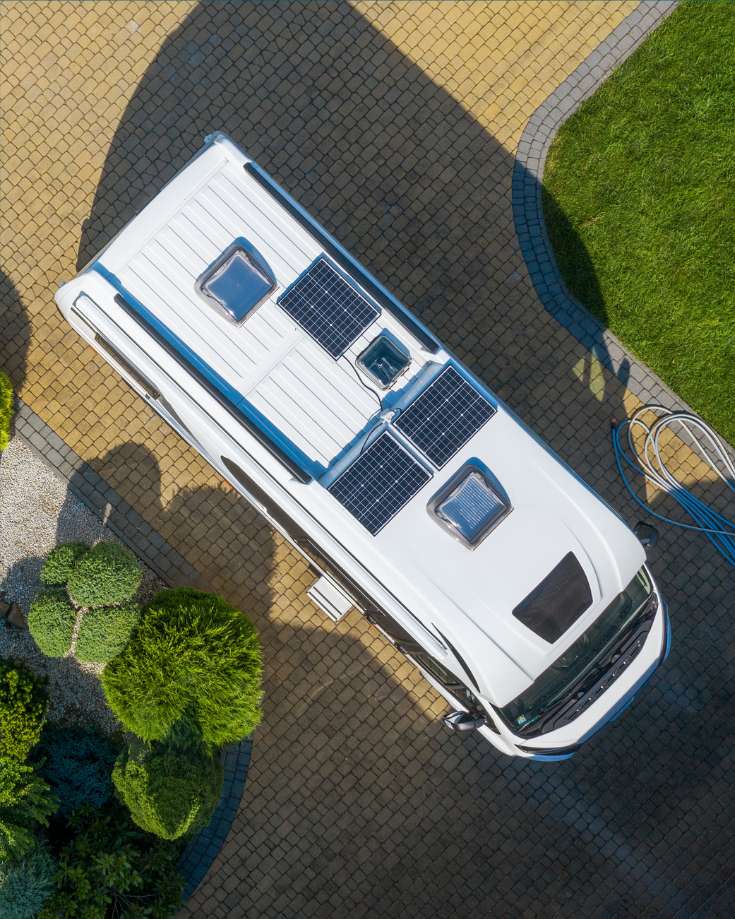
In short, a solar system for an RV consists of several components that work together to capture and store energy from the sun.
These components include:
- solar panels – harvest the sun’s energy,
- a charge controller – manages the current and voltage to enable the battery to charge,
- batteries – that store DC electricity,
- wiring – safely connects the components,
- an (optional) inverter – that converts DC power to AC.
Each component is crucial in converting sunlight into usable power for your RV appliances and devices.
Essentially, solar panels capture energy from the sun and convert it into direct current (DC) electricity.
This DC electricity flows through wiring to a charge controller, which regulates the charge flow into your batteries.
The batteries then store this energy until you need it to power your appliances and devices.
However, since many appliances and devices require alternating current (AC) electricity, an inverter is needed to convert the DC electricity stored in your batteries into AC electricity that your RV’s electrical system can use.
With all these components working together seamlessly, you’ll have access to clean and renewable energy no matter where your travels take you!
For a more detailed guide on how each component functions within an RV solar setup, check out our post: RV Solar Panels: A Beginners Guide.
There you’ll find all the information you need to get started.
How To Calculate How Much Solar Power You Need
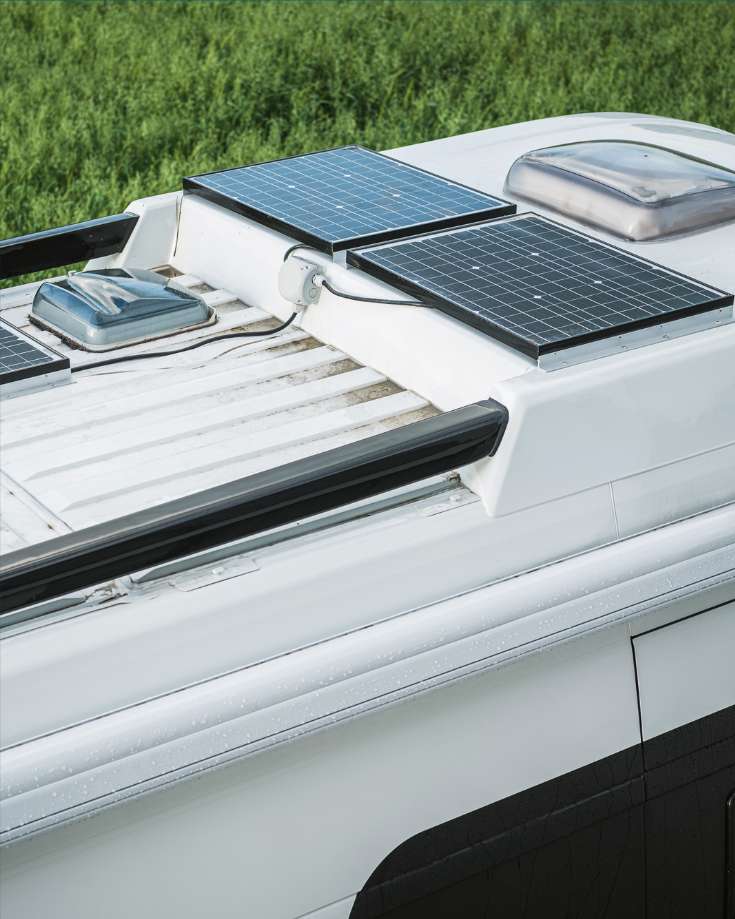
Determining how much solar power you need for your RV setup can be tricky, but we’ll walk you through it here.
There are three main factors to consider when figuring out how much solar power you need:
- How much energy do you use in your RV?
- How much energy can you generate?
- How much energy can you store?
We’ll look at each factor in more detail now.
How Much Energy Do You Use In Your RV?
When setting up a solar power system for your RV, one of the most important steps is calculating your daily power needs.
This involves looking at all the appliances and devices you plan on using while on the road and figuring out how much energy they consume daily.
There are three ways to figure it out:
1. Use Our RV Solar Calculator
This is the easiest way to size your entire RV solar system, and it’s FREE!
Fill in the details of your devices and appliances in the calculator and get instant results for your solar panels, battery size, charge controller, and inverter.
2. Calculate Your Power Needs Manually

To calculate your daily power needs, start by making a list of all the appliances and devices you’ll be using regularly. This might include lights, a refrigerator, stove, microwave, TV, and charging stations for phones or laptops.
Once you have your list, check each item’s wattage rating – this will tell you how much energy it consumes when used.
Next, estimate how long each appliance or device will be used on average.
For example, if you plan on using your TV for 2 hours per day and it has a wattage of 100 watts, that means it uses 200 watt-hours (Wh) per day.
If the appliance uses AC power, you must use an inverter to convert the battery bank’s DC power to AC. The conversion uses some energy, so for any AC appliance, multiply the daily Wh by 1.2.
Repeat this process for every item on your list to get the total number of Wh required daily.
Now you know your daily energy demand.
3. Use An RV Monitor or Power Management System To Assess Your Actual Use
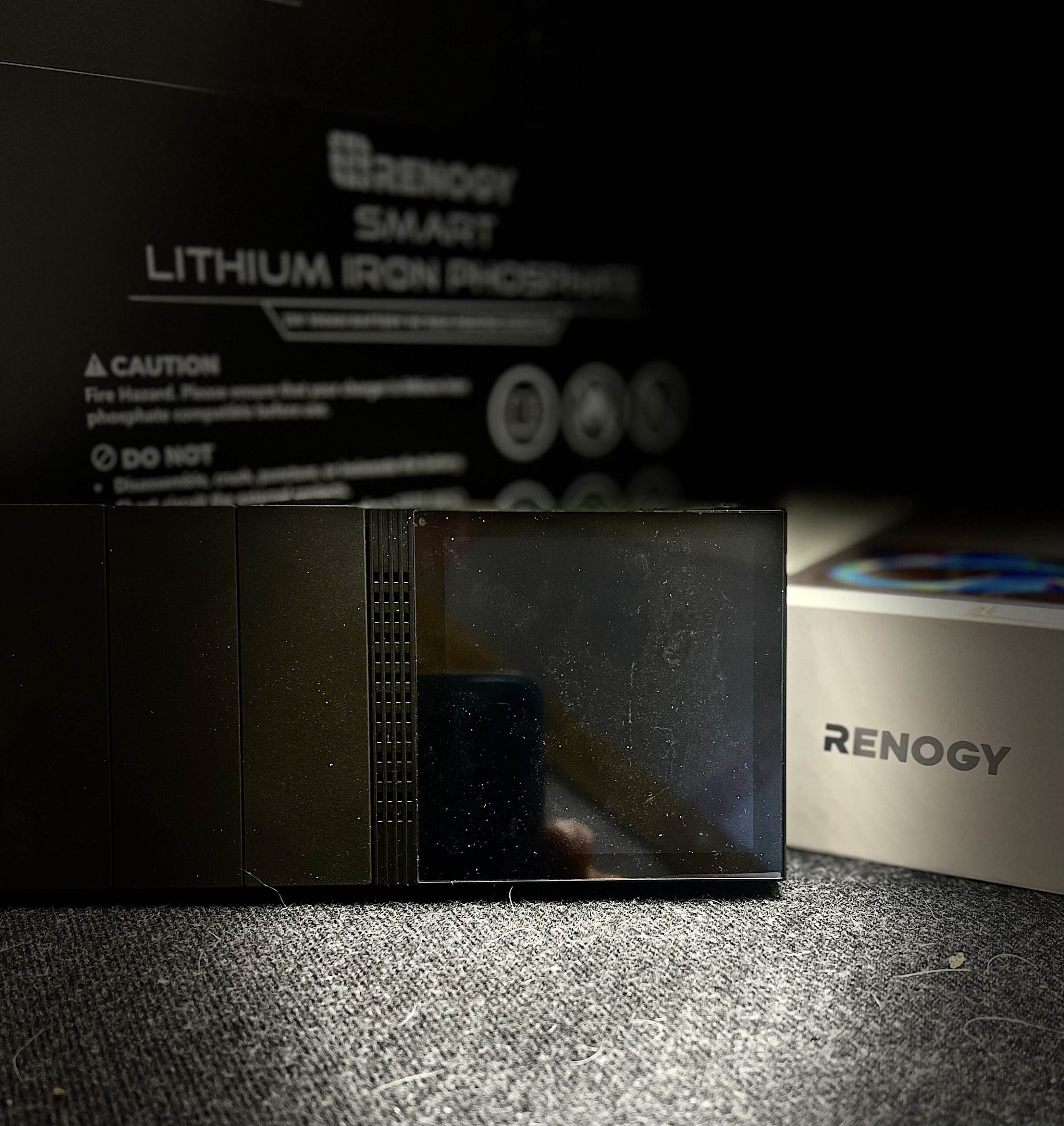
If you already use electricity in an RV, you can assess how much power you actually use.
The downside of this approach is that it doesn’t consider any seasonal differences.
For example, you will probably use more power in winter than summer. If you measure your load this way, adjust for seasonal changes or use one of the previous two methods.
Plus, battery monitors aren’t 100% accurate, so treat the results with some skepticism.
Using a basic RV battery monitor or power management system:
- Fully charge your battery,
- Unplug all charging supplies (shore power, generator, and alternator charging),
- Use your RV for 24 hours as normal,
- Read how many amp hours you’ve used.
- Multiply amp hours by your battery’s nominal voltage (usually 13v for lithium batteries or 12.6v for lead acid batteries).
That will give you the number of Wh you used in the previous 24 hours.
A top-of-the-range power management system may display the Wh without manual calculation.
As a word of caution, keep an eye on your battery levels during the test period to avoid flattening your battery bank. That may cause long-term damage and shorten the battery life.
The above approach doesn’t consider power used on dedicated RV AC circuits. If you already have an inverter installed, run your AC appliances through the inverter for the test period.
You can use a power meter if you don’t have an inverter or your battery bank isn’t yet big enough to run those appliances. However, they’re pretty expensive, so unless you already own one, we recommend using one of the other methods.
How Much Energy Can You Generate?

Once you know how many Wh you need per day, you can determine what size solar panel array.
Assuming you want to meet all your energy needs from solar, you need enough solar panels to generate at least that amount.
So how many solar panels do you need? You might think you can match watts of solar to Wh needed.
So, for example, you might think each 100w solar panel will generate 100w of power. It’s more complicated, though.
Instead, several factors affect how much energy a solar panel can generate:
- Your location and time of year,
- Weather conditions, and
- Solar charge controller.
Location, Season & Weather
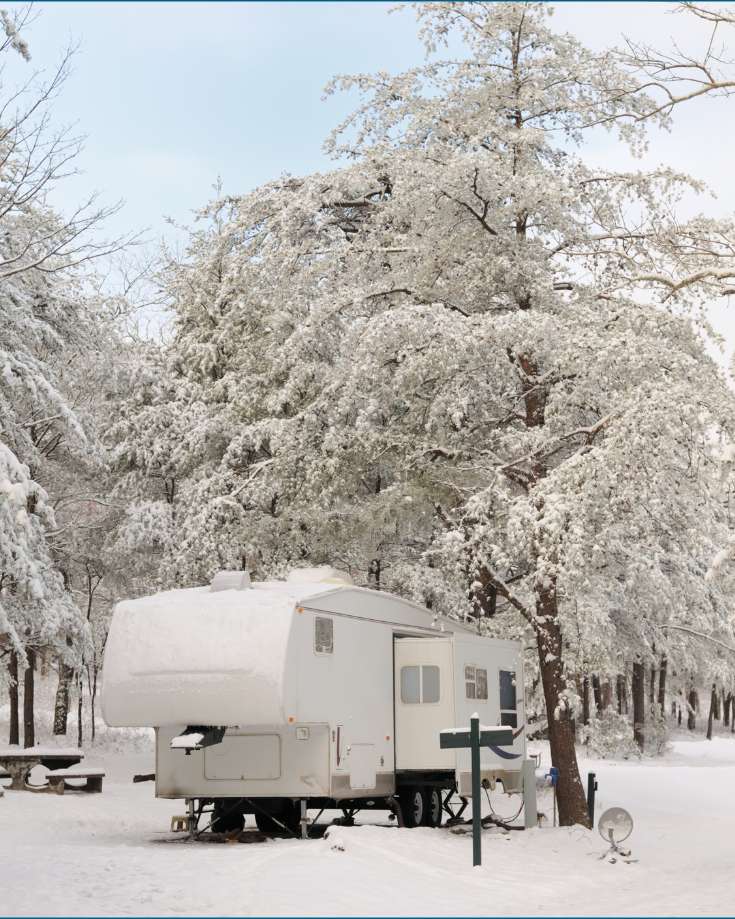
Your geographical location and time of year can significantly impact how much energy your solar panels can produce.
This is because solar panels rely on sunlight to generate electricity, and different locations and times of year experience varying amounts of sunlight.
For example, suppose you’re in a sunny area like Arizona or Southern California. In that case, your solar panels will likely produce more energy than if you’re located further north, like Seattle or London, England.
Additionally, the angle at which your roof-mounted panels are tilted towards the sun affects their efficiency.
Ideally, they should face south (in the Northern Hemisphere) and be tilted at an angle equal to your latitude.
The time of year also plays a role in energy production. During summer, when days are longer and there’s more direct sunlight, solar panels produce more energy than during winter, when days are shorter, and there’s less direct sunlight.
In fact, in some areas with very low levels of sunshine in winter, it may be difficult for solar panels to generate enough power to meet even basic needs.
Peak Sun Hours
The sun falling on your solar panels affects how much energy they can harvest.
Because the sun’s position in the sky varies throughout the year, the amount of energy they can harvest also varies.
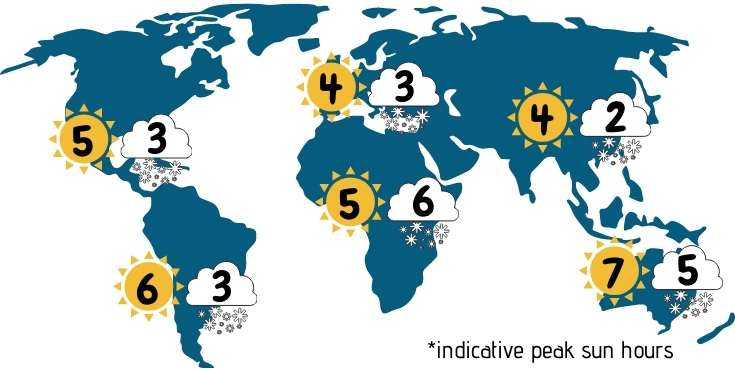
The map above gives a rough estimate of peak sun hours in winter and summer worldwide.
Use the lowest number for the locations where you’ll travel. For example, if you plan to travel:
- in North and South America, following the summer, use 5 hours
- in Europe and Africa, in winter, use 3 hours.
If you want to use more precise figures, the PV Education website gives average peak hours in a far more scientific way than our picture.
We encourage you to check because achieving 3 hours of peak sun in winter is impossible in some parts of the world.
Solar Charge Controller
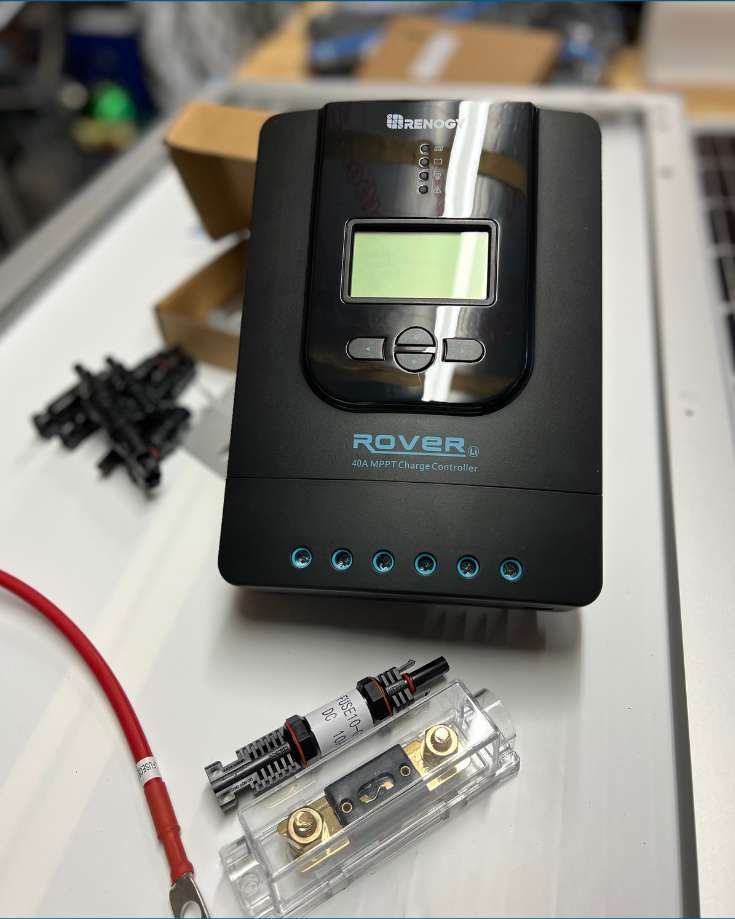
The solar charge controller is a critical component in a solar panel system, as it helps regulate the amount of energy transferred from the solar panels to the battery.
You can read more about solar charge controllers here, but in summary, they are not 100% efficient. As a result, you will lose some energy between the solar panel and the battery bank.
We recommend choosing an MPPT solar charge controller, which will be about 98% efficient.
So, How Many Solar Panels Do I Need?
Armed with:
- your total power consumption,
- the lowest peak sun hours for your travel locations, and
- the solar charge controller efficiency rating,
you can calculate how many solar panels you need.
(Power Consumption Wh / Solar Charge Controller Efficiency Rating)/ Peak Sun Hours
Example 1
Your power consumption is 2000 Wh, and your MPPT charge controller is 98% efficient.
You will only travel in summer around the US, and the lowest peak sun hours you’ll experience is 5 hours.
(Power Consumption Wh / Solar Charge Controller Efficiency Rating)/ Peak Sun Hours
(2000 Wh / 0.98)/ 5 = 408w
Rounding up the result, you’ll need 500w of solar panels to meet your demand.
Example 2
Your power consumption is 1500 Wh, and your MPPT charge controller is 98% efficient.
You will travel in summer around the US, and the lowest peak sun hours you’ll experience is 5 hours. But you will also travel to Canada for ski season; the lowest peak sun hours you’ll experience then is 0.75 hours.
(Power Consumption Wh / Solar Charge Controller Efficiency Rating)/ Peak Sun Hours
(1500 Wh / 0.98)/ 0.75 = 2040w
Rounding up the result, you’ll need 2100w of solar panels to meet your demand in winter.
Few RVs have space for that amount of solar panels, even with portable panels to bolster capacity. In summer, 400w will easily meet the power consumption.
If this looks like your scenario, you must consider minimizing your demand through winter, increasing battery power, or using additional charging sources.
How Much Energy Can You Store?
We’ve discussed how much solar you need to generate your power consumption, but the answer has potential problems. For example:
- What if you don’t have enough RV roof space for all those panels?
- What happens when you don’t experience the expected peak sun hours?
This is where your RV’s battery bank size comes into play.
The larger your battery bank, the more energy it can store. We have another free online calculator for sizing your solar battery bank.
But in general, your battery bank should be capable of storing at least enough usable energy to meet your daily power consumption.
We recommend a lithium battery bank and assume it has 80% usable power. In reality, they can discharge fully, but it’s a good safety parameter.
So, in example 1 above, we had a power consumption of 2000Wh which is 167ah of usable battery. For lithium, that’s a 200ah battery bank.
By doubling or even tripling the battery size, you effectively increase how long you can stay off-grid.
However, avoid being lulled into a false sense of security. You can only use the energy you put into the battery.
That means if you consistently use more energy than you harvest from solar, you will eventually flatten the battery.
Tips On Reducing Your Power Consumption
The total expected load is used as the basis for every other component of your electrical system, from batteries to solar panels and everything in between.
Look at how much power each of your appliances needs. Remember, generating electricity when off-grid can be challenging, especially in winter.
Question every item on the list, especially the appliances with the highest energy demands.
Ask yourself if they’re all necessary. If so, is there a low-powered, or better still, DC alternative available?
If you can’t, or don’t want to, rely on mains hookup, aim to minimize your total load.
Here are a few tips on reducing demand without much impact on your RV lifestyle:
- Identify the appliances with the most significant daily demand. Check you’ve correctly calculated the amount of time you’ll use them. For example, your refrigerator may run 24/7, but the compressor won’t run as long, depending on the ambient temperature.
- Ask yourself if each device is critical. If it is, do you have to use it off-grid, or can you plan to use it only when hooked up?
- Is there a 12v alternative available? Use DC appliances wherever possible because they use far less power than AC alternatives.
- Avoid electric appliances where there are alternatives. Water heaters and cookers are good examples of using propane instead of electricity.
- Use LED lights instead of traditional bulbs as they use less power.
- Roof vents are an alternative to powerful air conditioning units. They’re not as good at keeping the space cool but use a fraction of the energy.
The aim is to consider how you use electricity and how power-hungry each device is. It’s often not something we need to consider in a house but vital when sizing an RV’s electrical setup.
In Conclusion
Ultimately, there’s no one-size-fits-all answer to how much solar power you need for your RV setup.
It all depends on your unique energy needs and travel habits.
We recommend investing a few dollars in our Electrical Handbook if you need help figuring out where to start.
It covers everything you need to know about RV solar systems and much more, so you can better understand what kind of system will work best for you!
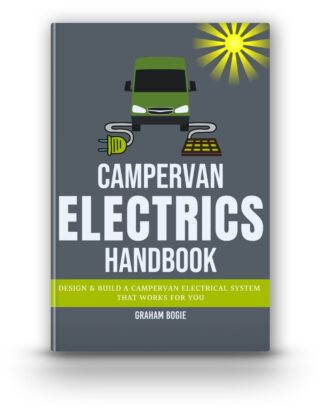
Everything you need to know about campervan electrics. Now available in ebook and paperback!
Learn how to design, size, install and troubleshoot your camper’s electrical system.
Have you sized a solar power system for your RV before? We’d love to hear about your experience! Whether you have tips for newbies or lessons learned, leave a comment below and share your insights with the community. Your input could be invaluable to someone just starting out on their solar-powered adventure!
Graham Bogie

Graham is a seasoned marine electrical engineer with two decades of experience designing customized electrical systems for plant machinery and converting campers and overland vehicles. His expertise has led him to author the reputable Campervan Electrics Handbook and become the chief designer of the RV Wiring Design Tool. As a knowledgeable figure in the field, his YouTube channel, blog, Facebook group, and newsletter, offering electrical advice and product reviews, reach more than a million users each year.


